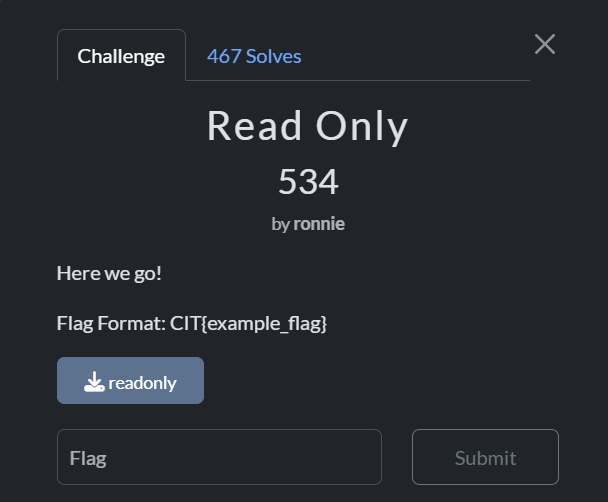CTF@CIT_REV
CTF@CIT!
Hello Everyone!
I recently participated in the CTF@CIT, which was a really fun experience, and I managed to secure the 18th place with my team L0ck8y7e among other 950 teams around the world, As for me, I solved 11 challenges distributed among MISC, Steganography, OSINT and Reverse.
In this Write-up, I’ll continue in the reverse side.

Read Only

This is very straightforward, as the name says, all we need to do is to read the strings, I used the strings command and piped it to grep to extract the flag in one step, and Voilà, here is our flag.

Flag: CIT{87z1BjG1968G}
Serpent

This file is a full obfuscated Python code that uses dumb names for its variables and functions and has lots of tricky math and character combinations, so let us take it step by step deobfuscating this script manually
You can use AI of course — but where’s the fun in that?
Simplify math
There are lots of very long math computations in the script, but in fact, each one represents only a constant, here is an example:
llllIlIlllIl = int(llIlIllIlIII[:int(((((116704136061.60963/964.3201898193925)/(0.428703923838846*886.9237724388992))/((0.0012060833880980187*881.8443963774392)*(130182.98979848581/481.8732951395559)))/(((29522.745228631833/649.7570061320558)/(1.4324981093115086*335.8825456577037))*((0.0017319883848935607*805.3839972167189)*(3.356677032714075*156.57728970259043)))))], int(((((5390772.534752933/864.0296058875497)/(26.83148167401528*27.364792970405322))/((0.0005708733226711018*740.6357840296969)*(102.92500351553784*9.678895359212218)))*(((14416.339800419119/546.3940490550166)*(0.6100297608738964*928.6839910352614))/((42.6015599384457*363.2887585003947)/(63167.78456455019/76.92378917865454))))))
After calculating the two equations, the code will be:
llllIlIlllIl = int(llIlIllIlIII[:16], 16)
Now, we can apply this to the entire code to make it more simple.
Renaming dummy names
Now, we have 6 functions and a class, the first one is:
def IlIIIlIIIIIlI(llIIIlIIlIIll: str) -> int:
llIlIllIlIII = hashlib.sha256(llIIIlIIlIIll.encode()).hexdigest()
llllIlIlllIl = int(llIlIllIlIII[:16], 16)
IlIlIIlIlII = ((llllIlIlllIl >> 3) ^ 0x5F5F5F5F) % 0xFFFFFFFF
return IlIlIIlIlII
This function takes a string as input and returns a deterministic pseudo-random 32-bit integer based on that string, so we can re write it as :
def generate_seed(input_str: str) -> int:
hash_hex = hashlib.sha256(input_str.encode()).hexdigest()
first_16_chars = int(hash_hex[:16], 16)
number = ((first_16_chars >> 3) ^ 0x5F5F5F5F) % 0xFFFFFFFF
return number
Next we have the following function:
def IIllIIIllIIlIIIIlIl(value: int, IIIllIIllllIII: int) -> int:
if IIIllIIllllIII <= 0:
return value
llIllIIllIIlII = ((value * 7 ) ^ (value >> 2)) & 0xFFFFFFFF
return IIllIIIllIIlIIIIlIl(llIllIIllIIlII + IIIllIIllllIII, IIIllIIllllIII - 1)
This function Recursively transforms the input value by applying a custom formula for a specified number of iterations, so we can rewrite it as:
def recursive_transform(value: int, iterations : int) -> int:
if iterations <= 0:
return value
transformed_value = ((value * 7) ^ (value >> 2)) & 0xFFFFFFFF
return recursive_transform(transformed_value + iterations , iterations - 1)
Now we have a class that contains 4 functions:
class Transformer:
def __init__(self, lIllIlIIIlIII: int):
self.lIllIlIIIlIII = lIllIlIIIlIII
def lIIllllIIllI(self) -> str:
lIllIIIlIlIIlIlIlII = math.sin(self.lIllIlIIIlIII % 360)
IIlIlIlIIlIIlI = f"{abs(int(lIllIIIlIlIIlIlIlII * 10000)):08d}"
return IIlIlIlIIlIIlI
def IIIlIIlIIlIl(self, IIIllIIlII: str) -> str:
lIIllIIlIllIll = 42
IIIlIIIlllIIlII = "".join(chr((ord(c) ^ lIIllIIlIllIll) & 0xFF) for c in IIIllIIlII)
IllllIIllIIl = base64.b64encode(IIIlIIIlllIIlII.encode()).decode()
return IllllIIllIIl
def IlIIIllIlIlIlI(self, IllllIIllIIl: str) -> int:
IIIIIIlIlIllII = hashlib.md5(IllllIIllIIl.encode())
lIlIlllllIllI = IIIIIIlIlIllII.hexdigest()
return int(lIlIlllllIllI[:8], 16)
This transformer applies a series of transformations to an integer input:
- Converts it using the sine function.
- Applies XOR encoding and Base64 encoding.
- Hashes the result with MD5 and extracts a portion of it.
So, the clean version of it could be like this:
class Transformer:
def __init__(self, value: int):
self.value = value
def transform_step1(self) -> str:
sine_value = math.sin(self.value % 360)
scaled_value = f"{abs(int(sine_value * 100000000)):08d}"
return scaled_value
def transform_base64_encoded(self, step1: str) -> str:
xor_key = 42
xor_encoded = "".join(chr((ord(c) ^ xor_key ) & 0xFF) for c in step1)
base64_encoded = base64.b64encode(xor_encoded.encode()).decode()
return base64_encoded
def transform_step3(self, base64_encoded: str) -> int:
md5_hash = hashlib.md5(base64_encoded.encode())
hex_digest = md5_hash .hexdigest()
return int(hex_digest[:8], 16)
After the class, we have another 4 functions, this is the first:
def IIllIllIIIIIIlIl(values: list) -> str:
IlIlIIllIl = sum(values)
IlIlIIllIl ^= 0xABCDEF
lIlIIIlllIIIllIII = 0
for digit in str(IlIlIIllIl):
lIlIIIlllIIIllIII = (lIlIIIlllIIIllIII * 31 + int(digit)) & 0xFFFFFFFF
IlIlIIlIIIlllIl = hex(lIlIIIlllIIIllIII)[2:]
lllIllIIlI = base64.b64encode(IlIlIIlIIIlllIl.encode())
IlIIIIlIlIIll = lllIllIIlI.decode()[:16]
IlIIIIlIlIIll = IlIIIIlIlIIll.rjust(16, chr(48))
return IlIIIIlIlIIll
This code sums the list, applies XOR, performs a custom hash-like transformation, encodes the result with Base64, and formats it to a 16-character string, so we can rewrite it as:
def generate_final_token(values: list) -> str:
total = sum(values)
total ^= 0xABCDEF
hashed_value = 0
for digit in str(total ):
hashed_value = (hashed_value * 31 + int(digit)) & 0xFFFFFFFF
hex_str = hex(hashed_value )[2:]
base64_encoded = base64.b64encode(hex_str.encode())
final_token = base64_encoded.decode()[:16]
final_token = final_token.rjust(16, chr(48))
return final_token
Then we have these 2 functions:
def lIllIlIIlIlllllIllll() -> str:
llIIIlIIlIIll = "S3cr3tS33d_For_CTFC0mp"
llIIllIIll = IlIIIlIIIIIlI(llIIIlIIlIIll)
llIIlIllIIllIIIIll = IIllIIIllIIlIIIIlIl(llIIllIIll, IIIllIIllllIII=10)
llIIIIIIlIIllll = Transformer(llIIlIllIIllIIIIll)
IIIllIIlII = llIIIIIIlIIllll.lIIllllIIllI()
IllllIIllIIl = llIIIIIIlIIllll.IIIlIIlIIlIl(IIIllIIlII)
IIIllIIlIII = llIIIIIIlIIllll.IlIIIllIlIlIlI(IllllIIllIIl)
IlIIIIIlIIIIlIIIIIII = (int(hashlib.sha1(IllllIIllIIl.encode()).hexdigest()[:8], 16)) & 0xFFFF
llllllIIlIlIIIIlI = IIllIllIIIIIIlIl([llIIllIIll, llIIlIllIIllIIIIll, IIIllIIlIII, IlIIIIIlIIIIlIIIIIII])
return llllllIIlIlIIIIlI
def IIIIlIIlIll(val: str) -> str:
lIIlIIlllIllllllIIll = 7
IlIlIlIIllIIIl = []
for c in val:
IlIlIlIIllIIIl.append(chr(((ord(c) - 48 + lIIlIIlllIllllllIIll) % 75) + 48))
return "".join(IlIlIlIIllIIIl)
Now, in this code the first function executes a series of transformations on a predefined input string S3cr3tS33d_For_CTFC0mp and returns the final processed result, then the second one shifts each character in its input by +7, modulo 75, inside a printable range, It’s a simple obfuscation or encoding technique.
now we can rewrite it like that:
def function_4() -> str:
input_str = "S3cr3tS33d_For_CTFC0mp"
initial_seed = generate_seed(input_str)
transformed_seed = recursive_transform(initial_seed , iterations =10)
transformer = Transformer(transformed_seed )
step1 = transformer.transform_step1()
base64_encoded = transformer.transform_base64_encoded(step1)
step3 = transformer.transform_step3(base64_encoded)
partial_hash = (int(hashlib.sha1(base64_encoded.encode()).hexdigest()[:8], 16)) & 0xFFFF
final_result = generate_final_token([initial_seed , transformed_seed , step3, partial_hash ])
return final_result
def function_5(val: str) -> str:
key = 7
str2 = []
for c in val:
str2.append(chr(((ord(c) - 48 + key) % 75) + 48))
return "".join(str2)
The next one is the main function, which looked like that after simplify its math and characters calculation :
def IllIlllIIllIlIIIIIlI():
IllIlllIIlll = lIllIlIIlIlllllIllll()
lllIIIllIllII = IIIIlIIlIll(IllIlllIIlll)
llIlIIIIIlllIIll = "".join("CIT{")
IllIIIllllIlII ="".join("}")
lIIlllllIl = llIlIIIIIlllIIll + lllIIIllIllII + IllIIIllllIlII
if __name__ == "__main__":
IllIlllIIllIlIIIIIlI()
which can be cleaned to:
def main():
var1 = function_4()
var2 = function_5(var1)
var3 = "CIT{"
var4 = "".join("}")
var5 = var3 + var2 + var4
if __name__ == "__main__":
main()
Now that we have a clear deobfuscated code that we understand how it works, we can run it and even edit it.
When we run the code, nothing happends, that is because the concatenated string CIT{ + Encoded string + } which is made in the main didn’t get printed, so adding this print line at the end of the main will result in printing the flag:
print(var5)
Flag: CIT{7777aKMpU9X3TqnD}
THE END